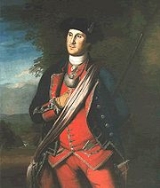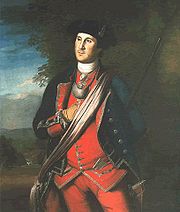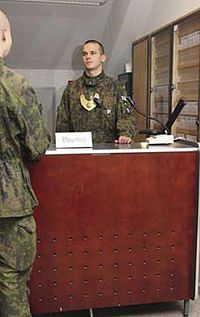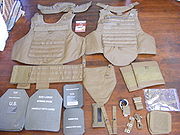
Gorget
Encyclopedia

Steel
Steel is an alloy that consists mostly of iron and has a carbon content between 0.2% and 2.1% by weight, depending on the grade. Carbon is the most common alloying material for iron, but various other alloying elements are used, such as manganese, chromium, vanadium, and tungsten...
or leather
Leather
Leather is a durable and flexible material created via the tanning of putrescible animal rawhide and skin, primarily cattlehide. It can be produced through different manufacturing processes, ranging from cottage industry to heavy industry.-Forms:...
collar
Collar (clothing)
In clothing, a collar is the part of a shirt, dress, coat or blouse that fastens around or frames the neck. Among clothing construction professionals, a collar is differentiated from other necklines such as revers and lapels, by being made from a separate piece of fabric, rather than a folded or...
designed to protect the throat
Throat
In vertebrate anatomy, the throat is the anterior part of the neck, in front of the vertebral column. It consists of the pharynx and larynx...
. It was a feature of older types of armour
Armour
Armour or armor is protective covering used to prevent damage from being inflicted to an object, individual or a vehicle through use of direct contact weapons or projectiles, usually during combat, or from damage caused by a potentially dangerous environment or action...
and intended to protect against sword
Sword
A sword is a bladed weapon used primarily for cutting or thrusting. The precise definition of the term varies with the historical epoch or the geographical region under consideration...
s and other non-projectile weapons. Later, particularly from the 18th century onwards, the gorget became primarily ornamental, serving only as a symbolic accessory on military uniforms.
As part of armour
Most Medieval versions of gorgets were simple neck protectors that were worn under the breastplate and backplate set. These neck plates supported the weight of the armour worn over it, and many were equipped with straps for attaching the heavier armour plates..png)
Renaissance
The Renaissance was a cultural movement that spanned roughly the 14th to the 17th century, beginning in Italy in the Late Middle Ages and later spreading to the rest of Europe. The term is also used more loosely to refer to the historical era, but since the changes of the Renaissance were not...
gorgets were not worn with a breastplate but instead were worn over the clothing. Most gorgets of this period were beautifully etched, gilt, engraved, chased, embossed, or enamelled and probably very expensive.
The Japanese (samurai
Samurai
is the term for the military nobility of pre-industrial Japan. According to translator William Scott Wilson: "In Chinese, the character 侍 was originally a verb meaning to wait upon or accompany a person in the upper ranks of society, and this is also true of the original term in Japanese, saburau...
) form of the gorget is known as a nodowa.
As part of military uniforms
As early as 1688, regulations provided for the wearing of gorgets by Swedish army officers. For those of captain's rank the gorget was gilt with the king's monogram under a crown in blue enamel, while more junior officers wore silver-plated gorgets with the initials in gold.During the 18th and early 19th centuries, crescent-shaped gorgets of silver or silver gilt were worn by officers in most European armies, both as a badge of rank and an indication that they were on duty. These last survivals of armour were much smaller (usually about three to four inches in width) than their Medieval predecessors and were suspended by chains or ribbons. In the British service they carried the Royal coat of arms until 1796 and thereafter the Royal cypher
Royal Cypher
In modern heraldry, a royal cypher is a monogram-like device of a country's reigning sovereign, typically consisting of the initials of the monarch's name and title, sometimes interwoven and often surmounted by a crown. In the case where such a cypher is used by an emperor or empress, it is called...
.
Gorgets ceased to be worn by British army officers in 1830, and by their French counterparts 20 years later. They were still worn to a limited extent in the Imperial German Army
German Army (German Empire)
The German Army was the name given the combined land forces of the German Empire, also known as the National Army , Imperial Army or Imperial German Army. The term "Deutsches Heer" is also used for the modern German Army, the land component of the German Bundeswehr...
until 1914, as a special distinction by officers of the Prussian Gardes du Corps and the 2nd Cuirassiers "Queen". Officers of the Spanish infantry continued to wear gorgets with the cypher of King Alfonso XIII in full dress until the overthrow of the Monarchy in 1931. Mexican Federal army
Mexican Army
The Mexican Army is the combined land and air branch and largest of the Mexican Military services; it also is known as the National Defense Army. It is famous for having been the first army to adopt and use an automatic rifle, , in 1899, and the first to issue automatic weapons as standard issue...
officers also wore the gorget with the badge of their branch as part of their uniform until 1947. This practice ended in 1947 but the gorgets are still used by all units when on guard duty. Recently the Mexican army's new 2010 model dress uniforms have re-incorporated the gorgets.

Nazi Germany
Nazi Germany , also known as the Third Reich , but officially called German Reich from 1933 to 1943 and Greater German Reich from 26 June 1943 onward, is the name commonly used to refer to the state of Germany from 1933 to 1945, when it was a totalitarian dictatorship ruled by...
, seeing widespread use within the German military and Nazi party organizations. During World War II, it continued to be used by German military field police
Feldgendarmerie
The Feldgendarmerie were the uniformed military police units of the armies of the German Empire from the mid 19th Century until the conclusion of World War II.- Early history :...
, which wore metal gorgets as emblems of authority. German police gorgets of this period typically were flat metal crescents with ornamental designs that were suspended by a chain worn around the neck. Following the German example, the Finnish
Finland
Finland , officially the Republic of Finland, is a Nordic country situated in the Fennoscandian region of Northern Europe. It is bordered by Sweden in the west, Norway in the north and Russia in the east, while Estonia lies to its south across the Gulf of Finland.Around 5.4 million people reside...
Defence Forces still use a metal gorget as a distinguishing mark of the duty conscript of a company
Company (military unit)
A company is a military unit, typically consisting of 80–225 soldiers and usually commanded by a Captain, Major or Commandant. Most companies are formed of three to five platoons although the exact number may vary by country, unit type, and structure...
, and the highly prussianised Chilean army
Chilean Army
The Chilean Army is the land arm of the Military of Chile. This 45,000-person army is organized into seven divisions, a special operations brigade and an air brigade....
still use the German style metal gorget in parades and in the uniform of their own Military Police.
Gorgets in Sweden
The gorget was discontinued as a rank insigniaInsignia
Insignia or insigne pl -nia or -nias : a symbol or token of personal power, status or office, or of an official body of government or jurisdiction...
for Swedish officers in the Swedish Armed Forces
Swedish Armed Forces
The Swedish Armed Forces is a Swedish Government Agency responsible for the operation of the armed forces of the Realm. The primary task of the agency is to train, organize and to deploy military forces, domestically and abroad, while maintaining the long-term ability to defend the Realm in the...
as of the year 1792, when epaulette
Epaulette
Epaulette is a type of ornamental shoulder piece or decoration used as insignia of rank by armed forces and other organizations.Epaulettes are fastened to the shoulder by a shoulder strap or "passant", a small strap parallel to the shoulder seam, and the button near the collar, or by laces on the...
s where introduced. However, use of the gorget was revived in 1799, when the Officer of the day
Officer of the day
At smaller military installations where no provost marshal has been assigned, the officer of the day is a detail rotated each day among the unit/post's commissioned officers to oversee security, guard, and law enforcement considerations...
was given the privilege of wearing a gorget which featured the Swedish lesser coat of arms. It has since been a part of the officers uniform (when he or she functions as "Officer of the day"), a custom which continues to this day. The same use of the gorget also continues in Norway, worn by officers / corporals responsible for guard changes, and "Inspecting Officers" (officer of the day).
Gorget patches

British Army
The British Army is the land warfare branch of Her Majesty's Armed Forces in the United Kingdom. It came into being with the unification of the Kingdom of England and Scotland into the Kingdom of Great Britain in 1707. The new British Army incorporated Regiments that had already existed in England...
general officers, and senior officers (in red, blue, crimson, yellow, or green according to branch) are called "gorget patches" in reference to this article of armour. Air officer
Air Officer
An air officer is a Royal Air Force officer of the rank of air commodore or higher. Such officers may be termed "officers of air rank". The term is also used by many Commonwealth nations who have a similar rank structure to the RAF....
s in the Indian
Indian Air Force
The Indian Air Force is the air arm of the Indian armed forces. Its primary responsibility is to secure Indian airspace and to conduct aerial warfare during a conflict...
and Sri Lankan air forces also wear gorget patches with one to five stars depending on their seniority.
RAF
Royal Air Force
The Royal Air Force is the aerial warfare service branch of the British Armed Forces. Formed on 1 April 1918, it is the oldest independent air force in the world...
officer cadet
Officer Cadet
Officer cadet is a rank held by military and merchant navy cadets during their training to become commissioned officers and merchant navy officers, respectively. The term officer trainee is used interchangeably in some countries...
s wear white gorget patches on their service dress and mess-dress uniforms. Very similar collar patches are worn by British army officer cadets at Sandhurst
Royal Military Academy Sandhurst
The Royal Military Academy Sandhurst , commonly known simply as Sandhurst, is a British Army officer initial training centre located in Sandhurst, Berkshire, England...
on the standup collars of their dark-blue "Number One" dress uniforms. These features of modern uniforms are a residual survival from the earlier practice of suspending the actual gorgets from ribbons attached to buttons on both collars of the uniform. Such buttons were often mounted on a patch of coloured cloth or gold embroidery.
The functional gorget today

Improved Outer Tactical Vest
The Improved Outer Tactical Vest, or IOTV, is an enhanced version of, and a replacement for, the older Outer Tactical Vest variant of the Interceptor body armor, as fielded by the United States Army...
and Modular Tactical Vest
Modular Tactical Vest
The Modular Tactical Vest or is a bulletproof vest originally adopted by the United States Marine Corps in 2006. The MTV was designed as a solution to shortcomings in the current, decade-old interceptor body armor and was selected after a rigorous proposal and examination process by the Marine...
systems respectively.
Other uses
The state flag of South CarolinaFlag of South Carolina
The flag of the state of South Carolina dates back to 1765 when opponents of the Stamp Act marched in protest behind a blue flag bearing three white crescents. In 1775 Colonel William Moultrie was asked by the Revolutionary Council of Safety to design a flag for the South Carolina troops to use...
may feature a stylized gorget in its upper-left quadrant, although this is a matter of controversy.
The term also refers to a broad patch of metallic-looking iridescent
Iridescence
Iridescence is generally known as the property of certain surfaces which appear to change color as the angle of view or the angle of illumination changes...
feathers on the throats of many male hummingbird
Hummingbird
Hummingbirds are birds that comprise the family Trochilidae. They are among the smallest of birds, most species measuring in the 7.5–13 cm range. Indeed, the smallest extant bird species is a hummingbird, the 5-cm Bee Hummingbird. They can hover in mid-air by rapidly flapping their wings...
s.
In colonial Australia
History of Australia
The History of Australia refers to the history of the area and people of Commonwealth of Australia and its preceding Indigenous and colonial societies. Aboriginal Australians are believed to have first arrived on the Australian mainland by boat from the Indonesian archipelago between 40,000 to...
gorgets were given to Aboriginal men by government officials and pastoralists as insignia of high rank or reward for services to the settler community. Frequently inscribed with the word "King" along with the name of the tribal group to which the recipient belonged (despite the absence of this kind of rank among indigenous Australians), the "breastplates", as they came to be known, were highly regarded by those Aboriginal men who received one. A number of these breastplates are included in the collection of the National Museum of Australia
National Museum of Australia
The National Museum of Australia was formally established by the National Museum of Australia Act 1980. The National Museum preserves and interprets Australia's social history, exploring the key issues, people and events that have shaped the nation....
.
See also
- Shell gorgetShell gorgetA shell gorget is a Native American art form of polished, carved shell pendants worn around the neck. The gorgets are frequently engraved, and are sometimes highlighted with pigments, or fenestrated ....
- Australian Aboriginal breastplates
- Burke and Wills expeditionBurke and Wills expeditionIn 1860–61, Robert O'Hara Burke and William John Wills led an expedition of 19 men with the intention of crossing Australia from Melbourne in the south to the Gulf of Carpentaria in the north, a distance of around 3,250 kilometres...

